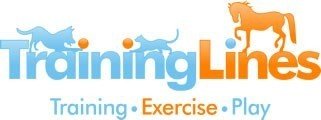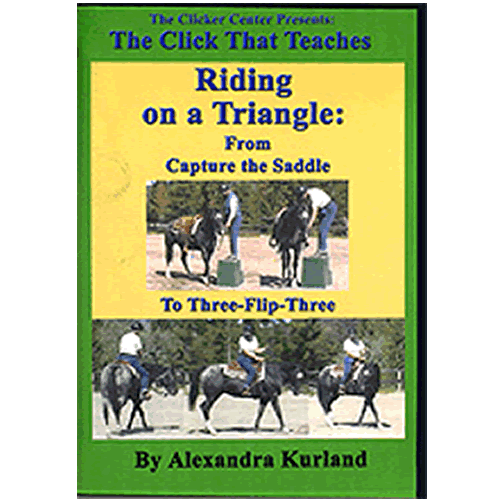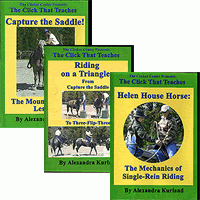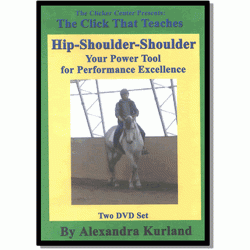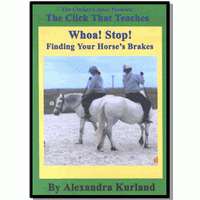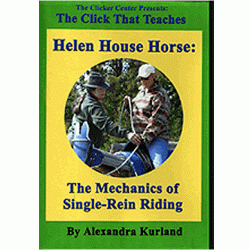DVD Lesson 12: Riding On A Triangle by Alexandra Kurland
Does your horse dance around at the mounting block? Sidle away when you put your foot in the stirrup? Riding On A Triangle shows how to use the power of cues to interrupt this pattern. Once you're on, it shows how to use single-rein riding to get a stuck horse moving and use a basic cone circle to create the beginnings of lateral work.
Approx 2 hours.
-
Delivery info
We are delighted to ship our products within the UK, and throughout Europe and the rest of the world
-
Payment methods
Pay securely online through PayPal (a PayPal account is not required), or contact us.

-
Returns
We accept returns
The longer we stay with an exercise the more good things it gives us.
This lesson beautifully illustrates this concept. It begins by looking at a very frustrating problem; a horse that siddles backwards each time the rider starts to get on. Over time horse and rider have evolved a long dance routine at the mounting block. The horse lines up beautifully, but she reads any move towards the stirrup as a cue to back up. Back up, come forward, back again. We've probably all seen it. This kind of mounting block jig is very common.
So the lesson begins by looking at the power of cues to interrupt this long standing pattern. It adds extra layers to the "Capture the Saddle" lesson presented in Lesson 11.
In the "Capture the Saddle" DVD you learn how to ask the horse to soften his jaw to the side and yield his hips to bring him to a stand still at the mounting block. So obviously, yielding the hips can get a horse to stop. Yielding the hips can also get a horse to go. The same basic exercise can create two very different results. In this DVD you'll see how we get a stuck horse to connect her feet to the reins and to go into motion.
That same softening the jaw and connecting the feet to the hips can now be used to ride a simple pattern around a circle of cones. This is the same exercise I introduced in the "Capture the Saddle" DVD, but now I'm going to take it a step further to show you an easy way to pop out the beginnings of lateral flexions. So in this one lesson we go from a stuck-in-cement horse to one that is beginning to flow into lateral flexions.
At the end of the lesson, just for fun, I show you what a horse can do who understands good balance.
Approx 2 hours.
Click Here to read what Alexandra Kurland says about her series of clicker training books and DVDs, and how to get the best from the lesson sequence.
We are delighted to ship our products within the UK, and throughout Europe and the rest of the world, and we make it a priority to dispatch as quickly as we can. 98% of orders are on their way within 24 hours (Mon-Fri) and almost 100% within a couple of days.
Most UK orders are delivered by Royal Mail, Parcel Force, or Hermes, and once you have entered your address and postcode information (or signed in), you will be presented with one or more delivery options.
For international orders, we choose the most appropriate carrier depending on a number of factors. Not all of our products are suitable for international shipping, and size and weight restrictions may apply. If we are unable to send one or more of your order items, we are always happy to discuss alternative options with you.
Click below for more details:
Some products are marked as 'UK Delivery Only' or have similar restrictions. For delivery in another region, please contact us before ordering so that we can advise you on the options available.

Pay securely through PayPal. A PayPal account is not required.
Prefer to speak to a person? No Problem! Simply select 'Contact Us' at the checkout, and call us with your payment details after you submit your order.
If you would like to return your item(s) to us, you are welcome to do so and can post them to the address on the reverse of your Invoice/Delivery Note. Please retain proof of posting.
We ask that you let us know in advance if you can, and package them securely so that they arrive undamaged. Please also include a note that explains who you are, your order number, and how you would like us to handle your return (whether you would like a refund or an exchange, for example). A copy of your Invoice/Delivery note would be fine.
It would also help us to know why you are returning your item(s), but this is entirely optional.
There are exceptions. We cannot accept returns of 'Special Order' or bespoke items, for example (such as imprinted clickers), and some other restrictions do apply. Please see our full Terms and Conditions.
Not sure what to do? Please contact us.

